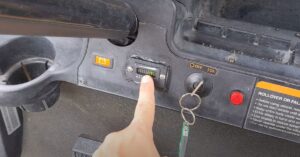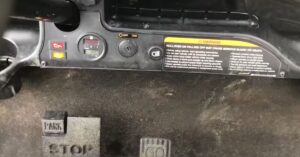Where Is The Solenoid On A Golf Cart?
Ready to venture into the world of golf cart mechanics? Let’s talk solenoids! These small but mighty components are essential for your golf cart to function properly. But where exactly is this critical part located?
The solenoid in a golf cart is typically found near the battery compartment. It’s usually mounted on the frame and connected directly to both the control switch and motor.
Curious about more than just its location? Stick around as we delve deeper into what a solenoid does, how it works, and why it’s such an integral part of your golf cart’s operation. Get ready to enhance your knowledge about these fascinating machines!
Key Takeaways
- The solenoid on a golf cart is a crucial component that controls the flow of electrical current.
- Located near the battery or controller, finding the solenoid is essential for troubleshooting and maintenance.
- Understanding how the solenoid works can help diagnose and fix common issues with your golf cart’s electrical system.
- Regular inspection and proper care of the solenoid can extend its lifespan and ensure optimal performance of your golf cart.
Where can I find the solenoid on a golf cart?
If you’re wondering where to locate the solenoid on your golf cart, we’ve got you covered. The solenoid is an essential component responsible for controlling the flow of electricity between the battery and the motor. By understanding its location, you’ll be better equipped to troubleshoot any potential issues that may arise.
To find the solenoid, start by locating the battery compartment on your golf cart. In most cases, it is located under the seat or in a designated area near the rear of the vehicle. Once you have identified this area, look for a small box-shaped device with wires connected to it – that’s your solenoid!
It’s important to note that different golf carts may have slightly varying configurations, so if you don’t immediately spot it in these common areas, consult your owner’s manual for specific instructions tailored to your model.
How does the solenoid function in a golf cart?
How does the solenoid function in a golf cart? The solenoid, a crucial component in a golf cart’s electrical system, serves as a switch that controls the flow of current between the battery and motor. When you press down on the accelerator pedal, it sends an electrical signal to the solenoid to engage.
Once engaged, the solenoid creates a magnetic field that pulls on a metal rod or plunger inside. This movement completes the circuit between the battery and motor, allowing electricity to flow and power the golf cart forward.
To ensure safety and efficiency, most solenoids are designed with built-in contacts that can handle high currents without overheating or causing damage. They also have protective measures like fuses or circuit breakers to prevent excessive current from flowing through.
Understanding how the solenoid functions is essential for troubleshooting any issues related to starting or powering your golf cart. If you experience problems such as no response when pressing down on the accelerator pedal or inconsistent performance, checking and potentially replacing your solenoid might be necessary.
Can I replace the solenoid on my own?
If you’re facing solenoid issues with your vehicle, you might be wondering if you can replace it on your own. The good news is that in many cases, replacing a solenoid is a task that can be done by DIY enthusiasts. However, there are a few factors to consider before embarking on this endeavor.
First and foremost, it’s important to assess your level of mechanical expertise. Replacing a solenoid requires some technical knowledge and skill. If you have experience working on cars or possess a good understanding of automotive systems, then tackling this project yourself may be feasible.
Next, consider the specific make and model of your vehicle. Different vehicles have different designs and requirements when it comes to replacing the solenoid. It’s essential to consult the manufacturer’s manual or reliable online resources for guidance tailored specifically to your car.
Additionally, take into account the accessibility of the solenoid within your vehicle’s engine compartment. Some models may have easily accessible solenoids that can be replaced without much hassle, while others may require removing other components or even disassembling parts of the engine.
Lastly, ensure that you have all the necessary tools and equipment required for the job. A basic set of hand tools along with any specialized tools recommended by manufacturers will likely be needed for a successful replacement.
What are the common signs of a faulty solenoid in a golf cart?
A faulty solenoid can cause various issues in your golf cart, leading to frustration and inconvenience during your game. But how can you identify if the solenoid is the culprit behind these problems? Let’s find out.
No Response When Pressing the Accelerator
One of the most common signs of a faulty solenoid is when you press down on the accelerator pedal, but nothing happens. Your golf cart fails to move forward or backward, indicating that power is not reaching the motor due to a malfunctioning solenoid.
Intermittent Starting Issues
If you experience sporadic starting problems with your golf cart, it could be due to a faulty solenoid. Sometimes it may start fine, while other times there might be delays or no response at all when turning the key or pressing the ignition button.
Audible Clicking Sound
A clicking sound coming from under the hood while attempting to start your golf cart often indicates a faulty solenoid. This noise occurs as an electrical current passes through damaged contacts within the solenoid.
Inconsistent Power Delivery
When driving your golf cart, if you notice sudden jerks or loss of power even though everything else seems normal (battery charge, wiring connections), it could be due to an intermittent fault in the solenoid.
safety precautions to consider when working with the solenoid
When working with a solenoid, it is important to take certain safety precautions to ensure your well-being and the proper functioning of the device. Let’s explore some of these precautions:
Disconnect the Power
Before starting any work on a solenoid, make sure to disconnect the power source. This will prevent any accidental electrical shocks or damage to the equipment.
Wear Protective Gear
Always wear appropriate protective gear such as gloves and safety glasses when handling a solenoid. This will protect you from potential injuries due to sharp edges or flying debris.
Check for Proper Grounding
Ensure that the solenoid is properly grounded before connecting or disconnecting any wires. Faulty grounding can lead to electrical malfunctions and pose a safety risk.
Follow Manufacturer Guidelines
Read and follow all instructions provided by the manufacturer regarding installation, maintenance, and troubleshooting of the solenoid. Following these guidelines will help minimize risks associated with improper usage.
Avoid Overloading
Do not exceed the maximum load capacity specified by the manufacturer for your solenoid. Overloading can cause overheating and may result in equipment failure or even fire hazards.
FAQs
How can I locate the solenoid on my golf cart?
The solenoid on a golf cart is typically located near the battery compartment or in close proximity to the controller. It is often mounted on the frame of the cart for easy access and maintenance.
Is there a specific way to identify the solenoid on a golf cart?
Yes, you can usually identify the solenoid by its cylindrical shape and electrical connections. It will have two large terminals, one for the battery and another for connecting to other components such as the motor or controller.
Can I follow any visual cues to find the solenoid on my golf cart?
Yes, you can look for wires leading from your batteries or controller that go towards a small metal box with electrical connections. This box is likely to be your solenoid.
What should I do if I still cannot locate the solenoid on my golf cart?
If you are unable to find it based on visual cues, consult your golf cart’s manual or contact the manufacturer’s customer support for guidance specific to your make and model of golf cart. They will be able to provide detailed information about where exactly it is located in your particular vehicle.


![How To Bypass Solenoid On Golf Cart? [Complete Guide] how-to-bypass-solenoid-on-golf-cart](https://giftedgolfers.com/wp-content/uploads/2023/06/how-to-bypass-solenoid-on-golf-cart-300x157.jpg)

